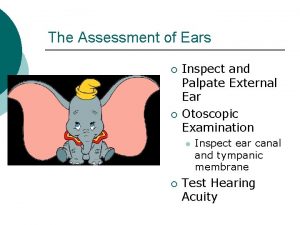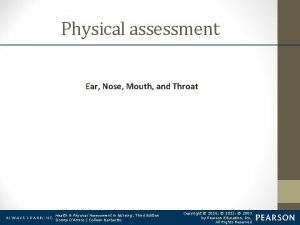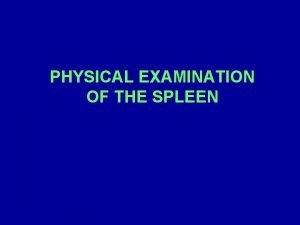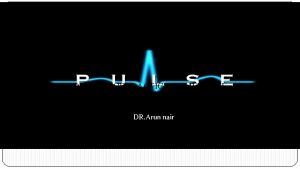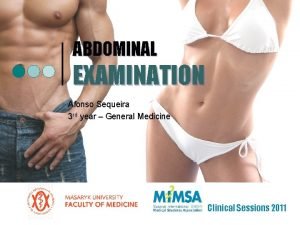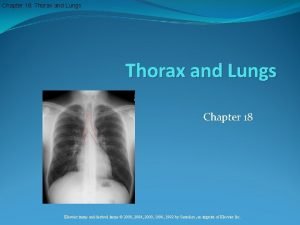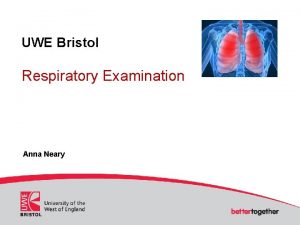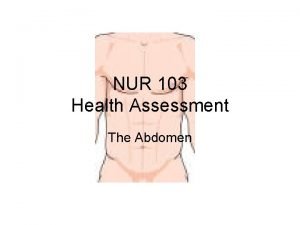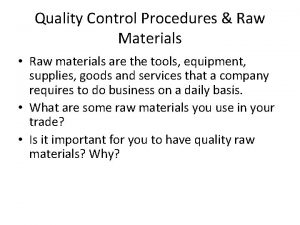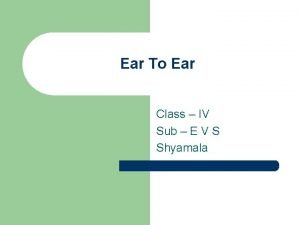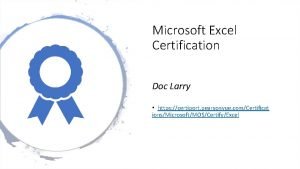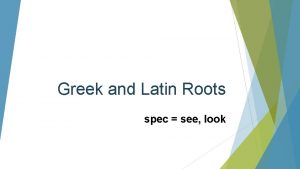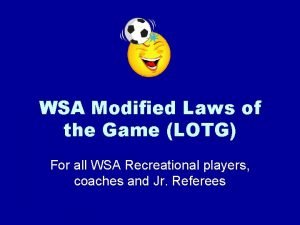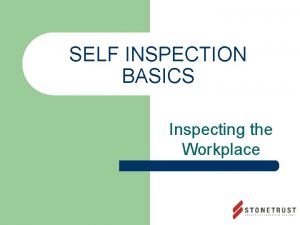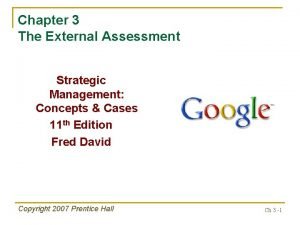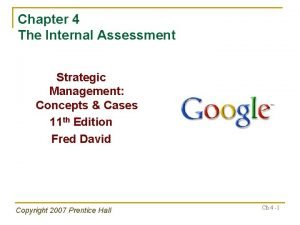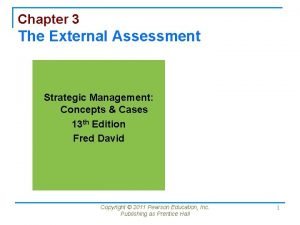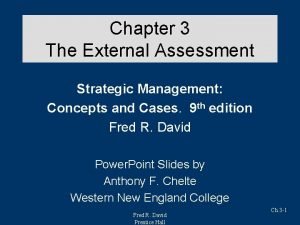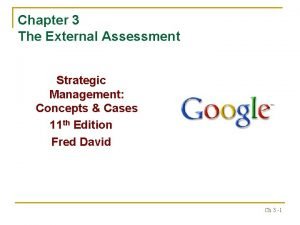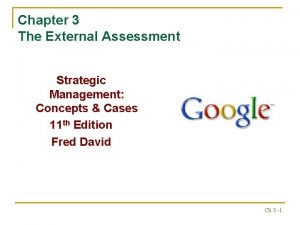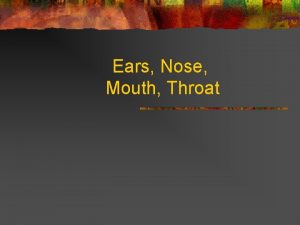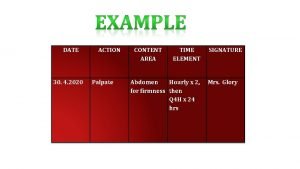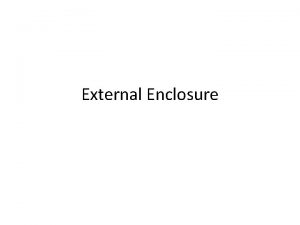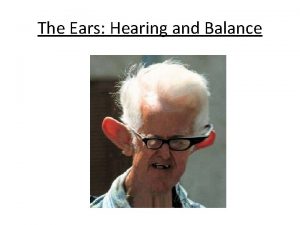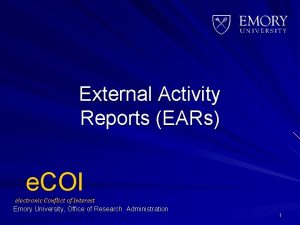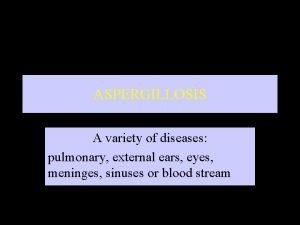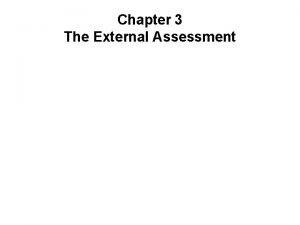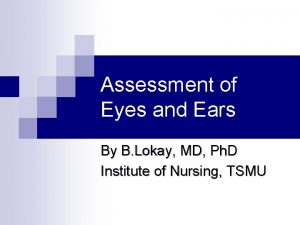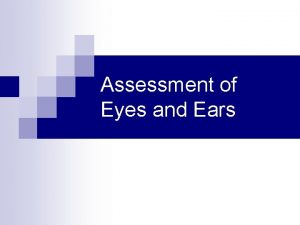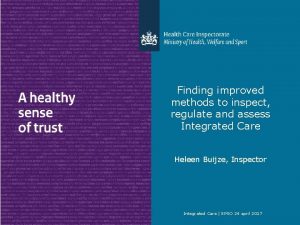The Assessment of Ears Inspect and Palpate External
































- Slides: 32

The Assessment of Ears ¡ ¡ Inspect and Palpate External Ear Otoscopic Examination l ¡ Inspect ear canal and tympanic membrane Test Hearing Acuity

The Ear Sensory organ for hearing and maintaining equilibrium ¡ Consists of movable cartilage and skin ¡ Contains 3 parts ¡ l l l External Ear Middle Ear Inner Ear




Pathways of Hearing ¡ ¡ ¡ Air Conduction- transmission of sound through ear canal. Bone Conduction- transmission of sound through the bones of the ear. NORMAL AC to BC ratio 2: 1

Hearing Loss ¡ Conductive Hearing Loss- caused by interference of air conduction of sound (outer to inner ear) due to change in outer or middle ear. ¡ Sensorineural Hearing Loss- structural changes or disorders of inner ear or auditory nerve. Damage to Organ of Corti - cranial nerve stimulation impaired ¡ Mixed Hearing Loss


Health History- Subjective Data for Ear Exam Pain-Otalgia ¡ Infections ¡ Discharge-Otorrhea ¡ Hearing Loss ¡ l l Presbycusis Nonverbal cues to loss? Environmental Noise ¡ Tinnitus ¡ Vertigo ¡

And More Subjective Information ¡ Past Medical History l l l ¡ Chronic Ear Infections Ear Surgery or Injury Perforation Family History l l l Hearing Loss Congenital Birth Defects Meniere’s Disease

More Subjective Information ¡ Present Health status l l Chronic Diseases Medications Hearing Aids Self care behaviors

Health Promotion & Protection Patterns Protection from Noise ¡ Routine Hearing Screening & Exams ¡ Cleaning of Ears ¡ Foreign Bodies in the Ear Canal ¡

Equipment & Examining Techniques ¡ Otoscope l l l ¡ Speculum to fit ear canal Positioning the speculum Pneumatic bulb attachment Tuning Fork

Objective - Physical Exam ¡ Inspect Outer Ear l l l ¡ Size Shape Alignment Color Darwin’s Tubercle Palpation l l Helix/Auricle/Pinna Tragus Mastoid process Preauricular and Postauricular Lymph nodes

Physical Exam of External Canal ¡ External Auditory Canal l Swelling l Pain with exam l Discharge l Foreign Body l Cerumen l Color l Irritation

Exam of the Tympanic Membrane ¡ USE OSTOSCOPE l ¡ ¡ ¡ Position for adults versus children Normal Color Shiny pearly gray and translucent Cone of light reflex in the antero-inferior quadrant (Right 5 o’clock, Left 7 o’clock) Pars Tensa, Pars Flaccida Annulus Malleus l l l Umbo Manubrium Short Process of Malleus

Exam of the Tympanic Membrane ¡ ¡ ¡ Eardrum is flat, slightly pulled in the center Flutters with Valsalva or Insufflation Abnormalities l l l Red, Inflamed, Yellow, Purulent Bulging or Retracted Decreased mobility Absent Landmarks Air/fluid levels Scarring

Testing Hearing Acuity – Cranial Nerve VIII 1. ¡ 2. ¡ 3. ¡ 4. ¡ 5. ¡ ¡ Whisper Test or Voice Test Finger-Rubbing Test Weber Test Rinne Test Audiometry Exam Normal AC to BC ratio = 2: 1

Rinne/Weber Tests

Evaluate Vestibular Function ¡ ¡ Test Acoustic/Vestibular-Cochlear Nerve (Cranial Nerve VIII) Romberg Test-balance ¡ Client should face you with feet together, arms at side, eyes open, then eyes closed for 20 seconds. l l Normal Findings are to maintain balance without stepping sideways Abnormal Findings are stepping sideways or widening the base of support

Developmental considerations Infants/Children ¡ Infants l l l EAC shorter & eustachian tubes wider More prone to infection Inner ear develops during the first trimester of pregnancy Startles to loud noise External ear birth defects Parental Smoking

Risk for Hearing Impairment: Infants Low Birth Weight ¡ Congenital Infection ¡ Perinatal Asphyxia ¡ High risk birth problems ¡ Chronic OM ¡

Racial Groups Highest Risk for Hearing Impairment Native Americans ¡ Alaskan Natives ¡ Pacific Islanders ¡

Behavioral Clues for Hearing Impairment ¡ ¡ ¡ Should startle to sound at birth 6 -8 month turns to sound and should babble Inattentive in conversation Reacts to movement more than sound Facial expression is strained or puzzled Asks to repeat statements Confuses words that sound alike Speech problem Shy and withdrawn Complains of earaches Hears better when it is quiet or without background noise

Age Variations Adolescents Contacts Sports ¡ Wrestling ¡ Repeated Loud Music ¡

Age Variations Elderly Decrease in sebaceous glands ¡ Increased cerumen production (accumulation/drier) ¡ Hair Cells in Organ of Corti degenerate after age 50 ¡ Bones of ossicle become fixed ¡ Types of hearing Loss ¡ l l Sensorineural - Presbycusis Conductive

Common Conditions of the Ear Associated with Hearing Loss Otosclerosis ¡ Presbycusis ¡ Cerumen ¡ Cholesteatoma ¡ Tinnitus ¡ Meniere’s Disease o

Common Ear Conditions Otitis Media ¡ Otitis Externa ¡ Myringitis ¡ Mastoiditis ¡ Tumor ¡ Abscess ¡ Hematoma ¡

Acute Otitis Media ¡ ¡ ¡ Bacterial/Viral Infection of Middle Ear Red, bulging TM Fever, Ear Pain Conductive Hearing Loss Common in Children

Serous Otitis Media ¡ ¡ ¡ Accumulation of Serous Fluid in the Middle Ear TM may be retracted, yellow, with air bubbles C/O Crackling or popping sound when yawning or swallowing Conductive Hearing Loss Associated with Allergies, Infection, Enlarged lymphoid tissue

Otitis externa (Swimmer’s ear)

Carcinoma
 Inspection of the external ear
Inspection of the external ear Philtrum
Philtrum Tonsis
Tonsis Physical examination of spleen
Physical examination of spleen A poplitea palpation
A poplitea palpation Vein of lower limb
Vein of lower limb Abdominal assessment percussion
Abdominal assessment percussion Increased tactile fremitus
Increased tactile fremitus Anterior respiratory assessment
Anterior respiratory assessment Normal findings of skin
Normal findings of skin Raw materials quality control
Raw materials quality control Washington and lafayette inspect the troops at valley forge
Washington and lafayette inspect the troops at valley forge An animal with ear like fans
An animal with ear like fans Https://certiport.pearsonvue.com/
Https://certiport.pearsonvue.com/ Tetris
Tetris Beal inspect
Beal inspect Inspect uniformity of skin color rationale
Inspect uniformity of skin color rationale Spec greek or latin
Spec greek or latin Why is tactile fremitus increased in pneumonia
Why is tactile fremitus increased in pneumonia Inspect
Inspect Inspect
Inspect Self inspect
Self inspect Inspect rx
Inspect rx Cognex ether inspect
Cognex ether inspect Cobol examine
Cobol examine Ip inspect audit-trail
Ip inspect audit-trail External-external trips
External-external trips Internal and external assessment in strategic management
Internal and external assessment in strategic management Internal assessment in strategic management
Internal assessment in strategic management External strategic management audit
External strategic management audit Internal and external assessment in strategic management
Internal and external assessment in strategic management Internal and external assessment in strategic management
Internal and external assessment in strategic management Internal and external assessment in strategic management
Internal and external assessment in strategic management
